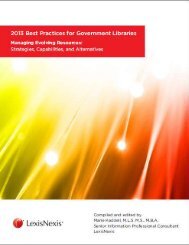2012 Best Practices for Government Libraries
2012 Best Practices for Government Libraries
2012 Best Practices for Government Libraries
You also want an ePaper? Increase the reach of your titles
YUMPU automatically turns print PDFs into web optimized ePapers that Google loves.
112<br />
BEST PRACTICES <strong>2012</strong><br />
2. International Labor Organization Conventions 29, 105, 138 & 182: Provisions<br />
ratified by up to 175 countries towards the elimination of <strong>for</strong>ced and child<br />
labor.<br />
3. U.S. FRAGO 06-188: Pentagon issued directive ensuring that the U.S.<br />
Department of Defense to eradicate human trafficking in labor recruiting<br />
practices.<br />
4. European Union Council Decision 2006/618/EC: Requires each EU member<br />
state to adopt measures to prevent and combat trafficking in persons.<br />
5. SAARC Convention on Regional Arrangements <strong>for</strong> the Promotion of Child<br />
Welfare in South Asia: Calls on all seven members of countries in South Asia<br />
to “eliminate the evil of child labor from the SAARC region.”<br />
CORPORATE RESPONSIBILITY AND GOOD GOVERNANCE:<br />
In the U.S. this year, Cali<strong>for</strong>nia enacted a “Supply Chain Transparency Act” that<br />
mandates corporations of a certain size doing business in the state to publicly<br />
disclose what steps they are taking to ensure that their supply chains are free of<br />
trafficked and slave labor. Supporters of the measure estimate that over 3,200<br />
multinational corporations are impacted by this law and subsequently many law<br />
firms are now establishing practices to advise these multi-national corporations to<br />
become compliant. A federal version of this act was introduced in Congress last<br />
year to expand nationally the provisions enacted by Cali<strong>for</strong>nia.<br />
LEXISNEXIS DUE DILIGENCE DASHBOARD:<br />
These laws were passed and multi-lateral agreements signed because of the global<br />
public’s heightened awareness about human trafficking, often referred to as a <strong>for</strong>m<br />
of modern day slavery, and our desire to not buy such tainted goods. What limits<br />
our diligence, however, is a lack of credible in<strong>for</strong>mation that procurement officials<br />
can access to ensure that their supply chains are free of goods produced through<br />
such exploitation. Increasingly, corporate and government procurement officials<br />
are in need of in<strong>for</strong>mation from trusted sources to help them uncover and manage<br />
potential risks and comply with legislative frameworks and international<br />
conventions. However, supply chains are complicated, and often times it is difficult<br />
to expose the last tier in a process that may span the globe.<br />
Due Diligence Dashboard, a LexisNexis product can assist. DDD synthesizes data<br />
from more than 20 global databases including public records and news and<br />
company filing in<strong>for</strong>mation to uncover risks in supply chains. For example, a DDD<br />
search of Foxconn, the contractor utilized by Apple to produce its products in China<br />
uncovered 1,500 negative news articles dating back to 1997. As the Apple example<br />
indicates, there are many benefits to accessing this type of in<strong>for</strong>mation: DDD allows<br />
<strong>for</strong> a company to make better decisions about its contractors by uncovering crucial<br />
in<strong>for</strong>mation to avoid devastating and costly risks to the company’s brand.



